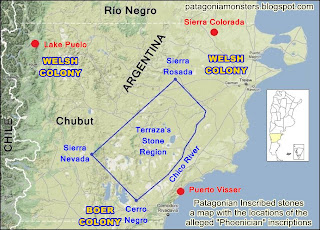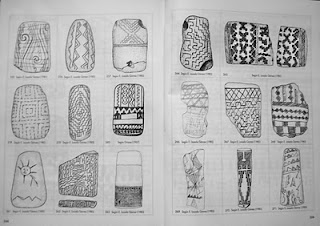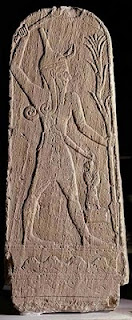Map showing where the Patagonian "Phoenician" inscriptions were found.
See Index on all my posts on Phoenicians in America.
Map showing the main sites and locations of the Phoenician inscribed stones of Patagonia. Copyright © 2011 by Austin Whittall
Let's take a look at the places where the "Phoenician" inscriptions were found. As I mentioned in my previous post, they are very different to the authentic native (Tehuelche) rock inscriptions, though they appear in the region which was the former homeland of these natives.
The places
Garcés [3] says that he bought (paid for, purchased - this is interesting as we will see in the next post) an inscribed stone from a Mr. Miguel Terraza, who told him that these stones come from the central part of the province.
Terraza indicated that they came from the area between Cerro Negro, Sierra Nevada, Sierra Rosada and the Chico River. A barren area. Just to the south of this region are lakes Colhue Huapi and Musters, fed by the Senguer River, which provides water to irrigate an agricultural colony settled by Boers who fled from the war that was raging between them and the British in South Africa in the last years of the nineteenth century and the early twentieth century. They settled around the current town of Sarmiento in southern Chubut.
According to Garcés, the custodian at the Rawson Museum (in 1943), [3] told him that there were over one hundred of those stones and that the Boers collected most of those stones and took them back to South Africa with them. He also noted that many foreigners also took them abroad.
To the east is Comodoro Rivadavia, an oil city, on the coast, which housed the "Lady of Elche" of the Patagonia, now lost.
Just north, along the coast is Punta Visser, where one of the Phoenician stones was found.
Still further north, is the original Welsh colony, at Madryn, Trelew, Rawson and Dolavon. The Museo Salesiano at Rawson, holds many of these "Phoenician" inscribed stones in its collection.
To the northwest of Rawson is Sierra Colorada. This is where I have managed to locate the site of another stone, which was said to come from "Chullucurá".
The name does not exist, there is no "Chullu" anywhere in Chubut. And regarding the second part of the place name, "Curá", fortunately there is only one place with the word "Curá" in it, and it is known as "Quelle Curá". [2]
This sounds very lie "Chullu", so it may be a typo or a spelling mistake. The place name means, in Mapuche language: "Quillá" or "Clá" = three, and "Curá" = Stones; therefore it is "three stones". [1] It is described as being located about 50 km to the northeast of the small village of Telsen, in northern Chubut. Exactly where I marked it on the map.
Garcés also mentions some stones that were collected by the wife of Dr. Elizagaray, the District Attorney at Trelew, one of which came from a place close to Puerto Lobos dug up when they laid the natural gas pipe from Patagonia to Buenos Aires. This place (which I did not mark on the map above) is located where the northern border of Chubut (white dashed line) meets the ocean, to the east of Sierra Colorada.
Then we have the inscription with the Yaz symbol (ⵣ) at Lake Puelo, in the western part of the province, in the Andean foothills, just to the north of the second Welsh colony (they moved west as their population grew in the late 1800s), at Esquel and Trevelin.
Remarks
The stones seem to come from two distinct areas. One along the northern part of the province, just north of the Chubut River, at is western sources (close to Lake Puelo) and on the coastal area north of its mouth on the Atlantic. The other is the central part of the province, a barren desolate place. What would people be doing there sculpting stones? Is there mineral wealth there?
I do recall however reading a remark by a Welsh explorer, Llywd ap Ewan who returning from an expedition to the Andes of Chubut and Santa Cruz, cut across from the fork where the Mayo and Senguer rivers meet and followed a route that lies roughly along the blue line (see map) that joins the Sierra Nevada and Sierra Rosada, and he wrote in his diary that he saw a strange stone columns or monoliths. I, just like the editor believed that it was some natural artifact, a rock carved by erosion (sandblasted by the relentless Patagonian winds) but, now, I am looking at it with another point of view. It may have been man made.
I will check the book and quote him here later.[4]
The City of Caesars and the Phoenicians
The “City of Caesars” was an “El Dorado” which is a tale that deserves a book of its own, yet it can be summarized as follows: The legend of the City of Caesars began in the mid XVIth century. It revolved around an incredibly rich city set in the hidden mountains of western Patagonia (i.e. its roads were paved with gold) and was inhabited by people of European origin who led secluded lives there. Several expeditions were sent to find it, and it was not until the late XVIIIth century that it lost credibility and searches were discontinued.
So you can imagine my surprise when I came across a map drawn by French scientist Martini de Moussy [5] showing it!
He had been commissioned by the Argentine government to study the geography of the country. After traveling throughout the country he produced his Description Geographique et Statistique de la Confederation Argentine (1860-1864) and an Atlas (1869). This Atlas contains several maps, and I reproduce part of one below:
Map showing the City of Caesars in 1869, Patagonia. Adapted from [5] by Austin Whittall
To the left (West) and quite far from its usual location in the Andes, is the City of "Los Cesares" (of Caesars), on one of the rivers that flows from the Andean foothills to form the Chubut River (in those days also known as Chupat). The Welsh colony figures in the map as a project. Note that above the colony are the "Calli he ches" Indians (exactly where the "Quelle" or "Chullu" site is). In Spanish, "Calli" "Quelle" and "Chullu" sound very similar.
What is the City of Caesars doing so far away from the Andes and the forests? Why is it set there in the middle of the steppe? Perhaps there was some mineral resource there?
Yes, actually, close to the sources of the Chubut River, at the town of Esquel there is gold, and the locals have been battling large mining concerns for years, to keep them from ruining the scenery and polluting the area if they ever get the necessary permits to mine the stuff.[6]
Could the City of Caesars by a Phoenician mining village? Were these wealthy people of "European" origin actually surviving "Phoenicians" or "Carthaginians"?
Intriguing, and something that I haven't seen written elsewhere. So it is an original idea! and backed by some (though I must admit tenuous) evidence.
We still have to look into the authenticity of these stones and consider the possibility that they are fake.
Sources.
[1] Lázaro Fleury, (1944). Guiliches, Tradiciones, leyendas, apuntes gramaticales y vocabulario de la zona pampa-araucana. Universidad de Córdoba. pp. 61.
[2] Rodolfo M. Casamiquela, (2000). Toponimia indígena del Chubut. Author's edition. pp. 213.
[3] Antonio Garcés,(1951). Libro del Cincuentenario de Comodoro Rivadavia, 1901-1951. Aspectos de la Arqueología Patagónica. Chap. 29.
[4] Roberts, T. and Gavirati, M., (2008) Diarios del Explorador Llywd ap Iwan. Villa Adelina: Patagonia Sur Libros; Gral. Roca: La Bitácora Patagónica.
[5] Martin de Moussy, (1865). Carte de la Patagonie et des archipels de la Terre de Feu, des Malouines et des cotes occidentales jusqu'au Golfe de Reloncavi.
[6] Gold at Esquel
Patagonian Monsters - Cryptozoology, Myths & legends in Patagonia2011 International Year of Forests Copyright 2009-2011 by Austin Whittall ©


































